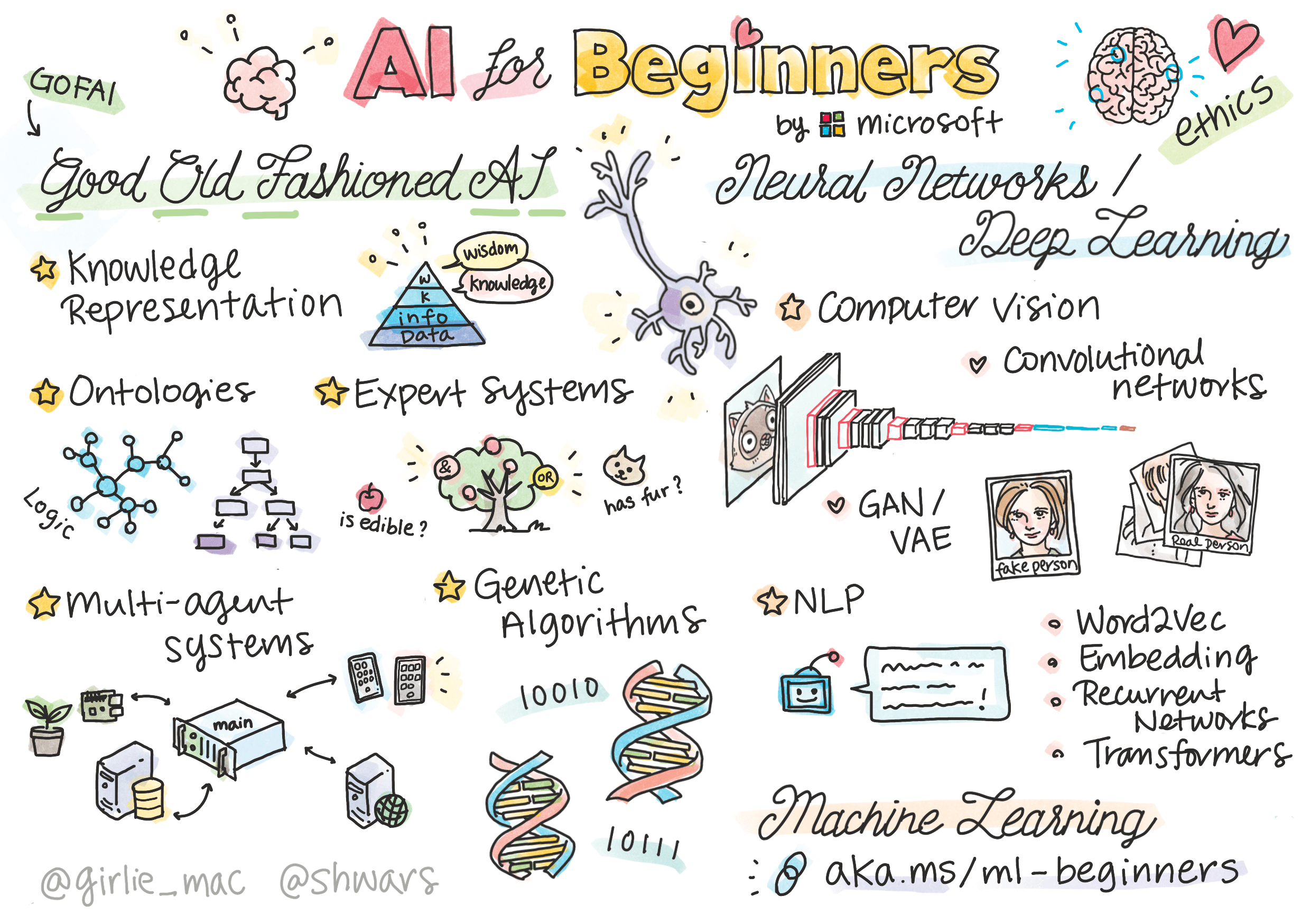Artificial Intelligence for Beginners
Azure Cloud Advocates at Microsoft are pleased to offer a 12-week, 24-lesson curriculum all about Artificial Intelligence.
In this curriculum, you will learn:
- Different approaches to Artificial Intelligence, including the “good old” symbolic approach with Knowledge Representation and reasoning (GOFAI).
- Neural Networks and Deep Learning, which are at the core of modern AI. We will illustrate the concepts behind these important topics using code in two of the most popular frameworks - TensorFlow and PyTorch.
- Neural Architectures for working with images and text. We will cover recent models but may lack a little bit on the state-of-the-art.
- Less popular AI approaches, such as Genetic Algorithms and Multi-Agent Systems.
What we will not cover in this curriculum:
- Business cases of using AI in Business. Consider taking Introduction to AI for Business Users learning path on Microsoft Learn, or AI Business School, developed in cooperation with INSEAD.
- Classic Machine Learning, which is well described in our Machine Learning for Beginners Curriculum.
- Practical AI applications built using Cognitive Services. For this, we recommend that you start with modules Microsoft Learn for Vision, Natural Language Processing, Generative AI with Azure OpenAI Service, and others.
- Specific ML Cloud Frameworks, such as Azure Machine Learning, Microsoft Fabric, or Azure Databricks. Consider using Build and Operate Machine Learning Solutions with Azure Machine Learning and Build and Operate Machine Learning Solutions with Azure Databricks learning paths.
- Conversational AI and Chat Bots. There is a separate Create Conversational AI Solutions learning path, and you can also refer to this blog post for more detail.
- Deep Mathematics behind deep learning. For this, we would recommend Deep Learning by Ian Goodfellow, Yoshua Bengio, and Aaron Courville, which is also available online at https://www.deeplearningbook.org/.
- For a gentle introduction to AI in the Cloud topics, you may consider taking the Get Started with Artificial Intelligence on Azure Learning Path.

| No | Lesson | Intro | PyTorch | Keras/TensorFlow | Lab |
|---|---|---|---|---|---|
| I | Introduction to AI | ||||
| 1 | Introduction and History of AI | Text | |||
| II | Symbolic AI | ||||
| 2 | Knowledge Representation and Expert Systems | Text | Expert System, Ontology, Concept Graph | ||
| III | Introduction to Neural Networks | ||||
| 3 | Perceptron | Text | Notebook | Lab | |
| 4 | Multi-Layered Perceptron and Creating our own Framework | Text | Notebook | Lab | |
| 5 | Intro to Frameworks (PyTorch/TensorFlow) and Overfitting | Text | PyTorch | Keras/TensorFlow | Lab |
| IV | Computer Vision | Microsoft Azure AI Fundamentals: Explore Computer Vision | |||
| Microsoft Learn Module on Computer Vision | PyTorch | TensorFlow | |||
| 6 | Intro to Computer Vision. OpenCV | Text | Notebook | Lab | |
| 7 | Convolutional Neural Networks CNN Architectures | Text Text | PyTorch | TensorFlow | Lab |
| 8 | Pre-trained Networks and Transfer Learning Training Tricks | Text Text | PyTorch | TensorFlow Dropout sample Adversarial Cat | Lab |
| 9 | Autoencoders and VAEs | Text | PyTorch | TensorFlow | |
| 10 | Generative Adversarial Networks Artistic Style Transfer | Text | PyTorch | TensorFlow GAN Style Transfer | |
| 11 | Object Detection | Text | PyTorch | TensorFlow | Lab |
| 12 | Semantic Segmentation. U-Net | Text | PyTorch | TensorFlow | |
| V | Natural Language Processing | Microsoft Azure AI Fundamentals: Explore Natural Language Processing | |||
| Microsoft Learn Module on Natural language processing | PyTorch | TensorFlow | |||
| 13 | Text Representation. Bow/TF-IDF | Text | PyTorch | TensorFlow | |
| 14 | Semantic word embeddings. Word2Vec and GloVe | Text | PyTorch | TensorFlow | |
| 15 | Language Modeling. Training your own embeddings | Text | PyTorch | TensorFlow | Lab |
| 16 | Recurrent Neural Networks | Text | PyTorch | TensorFlow | |
| 17 | Generative Recurrent Networks | Text | PyTorch | TensorFlow | Lab |
| 18 | Transformers. BERT. | Text | PyTorch | TensorFlow | |
| 19 | Named Entity Recognition | Text | TensorFlow | Lab | |
| 20 | Large Language Models, Prompt Programming and Few-Shot Tasks | Text | PyTorch | ||
| VI | Other AI Techniques | ||||
| 21 | Genetic Algorithms | Text | Notebook | ||
| 22 | Deep Reinforcement Learning | Text | PyTorch | TensorFlow | Lab |
| 23 | Multi-Agent Systems | Text | |||
| VII | AI Ethics | ||||
| 24 | AI Ethics and Responsible AI | Text | MS Learn: Responsible AI Principles | ||
| Extras | |||||
| X1 | Multi-Modal Networks, CLIP and VQGAN | Text | Notebook | ||
Each lesson contains some pre-reading material (linked as Text above), and some executable Jupyter Notebooks, which are often specific to the framework (PyTorch or TensorFlow). The executable notebook also contains a lot of theoretical material, so to understand the topic you need to go through at least one version of the notebooks (either PyTorch or TensorFlow). There are also Labs available for some topics, which give you an opportunity to try applying the material you have learned to a specific problem.
Some sections also contain links to MS Learn modules that cover related topics. Microsoft Learn provides a convenient GPU-enabled learning environment, although in terms of content you can expect this curriculum to go a bit deeper.
Credits
✍️ Primary Author: Dmitry Soshnikov, PhD <br/> 🔥 Editor: Jen Looper, PhD <br/> 🎨 Sketchnote illustrator: Tomomi Imura <br/> ✅ Quiz Creator: Lateefah Bello, MLSA <br/> 🙏 Core Contributors: Evgenii Pishchik

You must be logged in to post a comment.